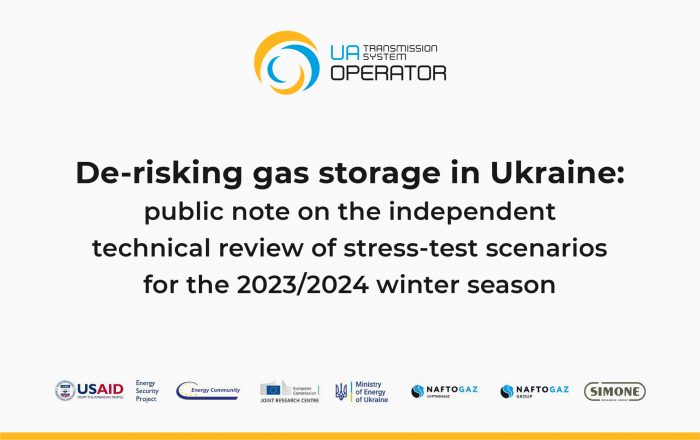The authorities of Ukraine and state-owned gas operators with the support of international partners carried out modeling and assessment of the risks of russian military aggression on the ability of European traders to safely store gas in Ukraine and transport it to Europe under the stress-test scenarios for 2023/2024 winter season.
De-risking-gas-storage-in-Ukraine_the-independent-technical-review-of-stress-test-scenarios (PDF)
GTSOU, with the support of the Ministry of Energy of Ukraine, initiated the relevant analysis to confirm the readiness of the Ukrainian gas infrastructure for the heating season of 2023/2024, as well as to reduce concerns about security risks on the part of international customers, who are interested in storing gas in Ukraine.
The stress-test is the joint product of the USAID Energy Security Project (ESP), the Energy Community Secretariat (EnCS), the Directorate General “Joint Research Centre” of the European Commission (JRC)[1], the Ministry of Energy of Ukraine (MoE), the Ukrtransgaz (UTG), the Naftogaz of Ukraine, the Gas Transmission System Operator of Ukraine (GTSOU), and the Simone Research Group (SRG).
Based on results of performed technical analysis, the working group reached the following conclusions:
- It is possible to re-export the amount of gas that is expected to be accumulated in UTG’s gas storage facilities in customs warehouse mode from Ukraine to the EU under the analyzed stress-test scenarios. This is possible regardless of whether the gas evacuation must occur in a shorter period or if it will take place across the entire winter season, until the end of March 2024.
- Ukraine’s gas infrastructure has high reliability and resilience due to significant reserve capacities that were used to regulate export regimes during the crisis situations modeled.
- Different combinations of transportation routes between storage facilities and the Ukraine-EU cross-border points were confirmed; these can substitute for one another and allow the quick switching of routes at very short notice.
At the time of writing, EU gas storage facilities exceeded 90 percent of their capacity. This means using the additional available gas storage facilities in Ukraine will be important to guarantee continuous energy availability for the EU member states and mitigate spikes in spot market prices. While Ukraine boasts the largest storage capacities in Europe and the third largest globally, attracting European traders to use these extensive facilities requires more than just market conditions (which are already in place); it also requires an analysis due to the russian’s ongoing war against Ukraine. This work serves that purpose: to assess different risk scenarios that would have an impact on the functioning of Ukraine’s gas infrastructure and EU customers’ ability to withdraw gas during the 2023/2024 winter season.
Public note on all stress-test scenarios is available via the link.
[1] Observer role
